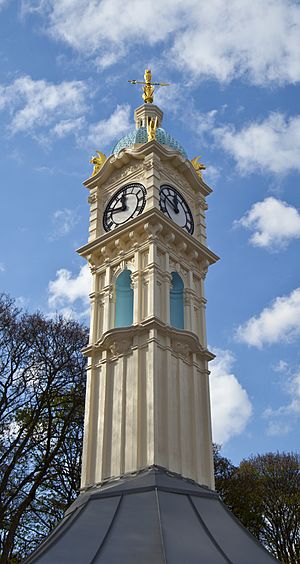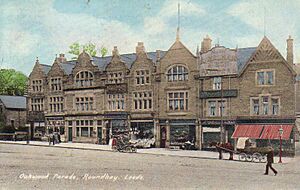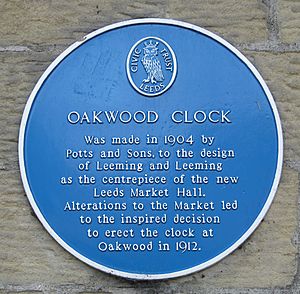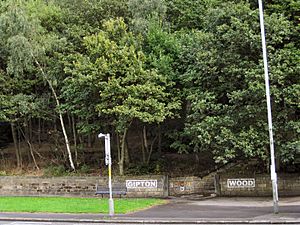Oakwood, Leeds facts for kids
Quick facts for kids Oakwood |
|
|---|---|
 The Oakwood Clock tower following restoration. 2015. |
|
| Metropolitan borough | |
| Metropolitan county | |
| Region | |
| Country | England |
| Sovereign state | United Kingdom |
| Post town | LEEDS |
| Postcode district | LS8 |
| Dialling code | 0113 |
| Police | West Yorkshire |
| Fire | West Yorkshire |
| Ambulance | Yorkshire |
| EU Parliament | Yorkshire and the Humber |
| UK Parliament |
|
Oakwood is a lively area in north-east Leeds, West Yorkshire, England. It's located right between Gipton and the famous Roundhay Park. This area is part of the LS8 postcode. It also falls under the Roundhay ward for Leeds City Council and the Leeds North East area for the UK Parliament.
Contents
What's in a Name?
The name "Oakwood" is quite simple. It comes from the oak tree species. The area was likely named after Oakwood House. This grand old house has since been updated. It is now a retirement home called Sabourn Court.
Oakwood's Past
Early Days and Oakwood House
Long ago, Oakwood was a small countryside area. It was part of the larger Roundhay estate. This land was near Roundhay Park. A man named George Goodman owned it. Oakwood was closely connected to the city of Leeds.
In 1825, Goodman sold the land. A rich wool merchant family bought it. Soon after, they started building Oakwood House. It was first called Wood End. The house changed owners many times. In 1865, the Hudson family bought it. They renamed it Oakwood House. By 1867, the name Oakwood was also used for the land around the house. In 1891, much of this land was sold. This sale helped create Oakwood as a settlement.
How Oakwood Grew
The sale of the Oakwood Building Estate led to Oakwood Parade. This was a row of shops and homes. The first four buildings were ready in 1894. The whole parade was finished by the 1920s.
The Fish Bar is the oldest shop still open on the Parade. It has been selling fish and chips since 1934. It's a Grade II Listed Building. This means it's a special historic building. It has cool black glass panels from the Art Deco style.
The Famous Oakwood Clock
The most famous part of Oakwood is its clock tower. The Oakwood Clock was built in 1904. It was designed by Leeming and Leeming. It sits at the bottom end of Roundhay Park.
This clock was first meant for Kirkgate Market. But the market's design changed. So, the clock was moved to Oakwood. Eight years after it was built, it was put up in Oakwood. In 2015, the tower was replaced. But the original clock was kept.
First Ever Movie Scene
You might not know this, but a very important event happened in Oakwood. In 1888, Louis Le Prince filmed the "Roundhay Garden Scene" here. This happened in the garden of Oakwood Grange. Many people say this was the very first motion picture ever!
Oakwood Grange was taken down in 1972. A housing estate was built there instead. But the nearby Oakwood Hall is still standing. It is now a nursing home.
Places to Visit
Oakwood has many useful places. On Roundhay Road, you'll find the Post Office. There's also a supermarket, currently Home Bargains. It used to be other stores like Netto and Safeway. Further down, you'll find Tesco. Oakwood Library is also a great spot. It's on the corner, across from the Oakwood Clock.
Oakwood Farmers' Market
The Oakwood Farmers' Market is a regular event. It happens on the third Saturday of every month. It started on March 15, 2008. The market is set up around the Oakwood Clock.
Local people help organize it. Their goal is to offer good quality local food. Some of it is organic. "Local" means the food comes from no more than 20 miles away. The market has special approval called FARMA accreditation. This shows it's a "true farmers' market."
You can find many local products here. These include jams, meats, eggs, chocolates, and fresh bread. There are also lots of local fruits and vegetables. Sometimes, local musicians and artists perform there too!
Nearby Areas and Borders
Oakwood doesn't have official borders. The A58 Easterly Road is often seen as the border between Oakwood and Gipton. This is how city council areas are often divided.
Because the LS8 postcode includes areas like Fearnville, Gipton, and Harehills, they are sometimes linked to Oakwood. For example, Oakwood Primary School has the name "Oakwood." But it is actually located in Gipton.
Even though Roundhay and Oakwood are separate areas, some places in Oakwood use the name Roundhay. This is because Roundhay is the name of the council ward. So, the Post Office and Tesco in Oakwood might say they are in Roundhay.
Gipton Wood
Gipton Wood is a woodland area in Leeds. It's shaped like a triangle. It's bordered by Oakwood Boundary Road, Roundhay Road, and Copgrove Road. The wood is about 8.2 hectares in size. It's part of the Forest of Leeds.
This is a very old woodland. People lived here in the Stone Age, Bronze Age, and Roman times. The main trees are oak, sycamore, beech, and hornbeam. The city was given the wood in 1923. Now, the City of Leeds and a group called "Friends of Gipton Wood" take care of it.
There's a pub across the road that used to be called "The Gipton." But its name has changed to "The Roundhay." The residential area known as Gipton Wood is south of the actual wood, down to Easterly Road.
Gallery
Where is Oakwood?
 |
Roundhay |  |
||
| Gledhow | Seacroft | |||
| Gipton |










